Cohen I.M., Kundu P.K. Fluid Mechanics
Подождите немного. Документ загружается.


662 Geophysical Fluid Dynamics
a barotropic gravity wave speed of c ∼ 200 m/s, and a baroclinic gravity wave speed
of c ∼ 2m/s. The shortest period of midlatitude baroclinic Rossby waves in the ocean
can therefore be more than a year.
The eastward phase speed is
c
x
=
ω
k
=−
β
k
2
+ l
2
+ f
2
0
/c
2
. (14.119)
The negative sign shows that the phase propagation is always westward. The phase
speed reaches a maximum when k
2
+l
2
→ 0, corresponding to very large wavelengths
represented by the region near the origin of Figure 14.28. In this region the waves are
nearly nondispersive and have an eastward phase speed
c
x
−
βc
2
f
2
0
.
With β = 2 × 10
−11
m
−1
s
−1
, a typical baroclinic value of c ∼ 2m/s, and a mid-
latitude value of f
0
∼ 10
−4
s
−1
, this gives c
x
∼ 10
−2
m/s. At these slow speeds the
Rossby waves would take years to cross the width of the ocean at midlatitudes. The
Rossby waves in the ocean are therefore more important at lower latitudes, where
they propagate faster. (The dispersion relation (14.118), however, is not valid within
a latitude band of 3
◦
from the equator, for then the assumption of a near geostrophic
balance breaks down. A different analysis is needed in the tropics. A discussion of
the wave dynamics of the tropics is given in Gill (1982) and in the review paper by
McCreary (1985).) In the atmosphere c is much larger, and consequently the Rossby
waves propagate faster. A typical large atmospheric disturbance can propagate as a
Rossby wave at a speed of several meters per second.
Frequently, the Rossby waves are superposed on a strong eastward mean current,
such as the atmospheric jet stream. If U is the speed of this eastward current, then the
observed eastward phase speed is
c
x
= U −
β
k
2
+ l
2
+ f
2
0
/c
2
. (14.120)
Stationary Rossby waves can therefore form when the eastward current cancels the
westward phase speed, giving c
x
= 0. This is how stationary waves are formed down-
stream of the topographic step in Figure 14.20.A simple expression for the wavelength
results if we assume l = 0 and the flow is barotropic, so that f
2
0
/c
2
is negligible in
equation (14.120). This gives U = β/k
2
for stationary solutions, so that the wave-
length is 2π
√
U/β.
Finally, note that we have been rather cavalier in deriving the quasi-geostrophic
vorticity equation in this section, in the sense that we have substituted the approximate
geostrophic expressions for velocity without a formal ordering of the scales. Gill
(1982) has given a more precise derivation, expanding in terms of a small parameter.
Another way to justify the dispersion relation (14.118) is to obtain it from the general
dispersion relation (14.76) derived in Section 10:

16. Barotropic Instability 663
ω
3
− c
2
ω(k
2
+ l
2
) − f
2
0
ω − c
2
βk = 0. (14.121)
For ω f , the first term is negligible compared to the third, reducing
equation (14.121) to equation (14.118).
16. Barotropic Instability
In Chapter 12, Section 9 we discussed the inviscid stability of a shear flow U(y) in a
nonrotating system, and demonstrated that a necessary condition for its instability is
that d
2
U/dy
2
must change sign somewhere in the flow. This was called Rayleigh’s
point of inflection criterion. In terms of vorticity
¯
ζ =−dU/dy, the criterion states
that d
¯
ζ/dy must change sign somewhere in the flow. We shall now show that, on a
rotating earth, the criterion requires that d(
¯
ζ + f )/dy must change sign somewhere
within the flow.
Consider a horizontal current U(y)in a medium of uniform density. In the absence
of horizontal density gradients only the barotropic mode is allowed, and U(y) does
not vary with depth. The vorticity equation is
∂
∂t
+ u
•
∇
(ζ + f) = 0. (14.122)
This is identical to the potential vorticity equation D/Dt[(ζ + f)/h]=0, with the
added simplification that the layer depth is constant because w = 0. Let the total flow
be decomposed into background flow plus a disturbance:
u = U(y) + u
,
v = v
.
The total vorticity is then
ζ =
¯
ζ + ζ
=−
dU
dy
+
∂v
∂x
−
∂u
∂y
=−
dU
dy
+∇
2
ψ,
where we have defined the perturbation streamfunction
u
=−
∂ψ
∂y
,v
=
∂ψ
∂x
.
Substituting into equation (14.122) and linearizing, we obtain the perturbation vor-
ticity equation
∂
∂t
(∇
2
ψ) + U
∂
∂x
(∇
2
ψ) +
β −
d
2
U
dy
2
∂ψ
∂x
= 0. (14.123)
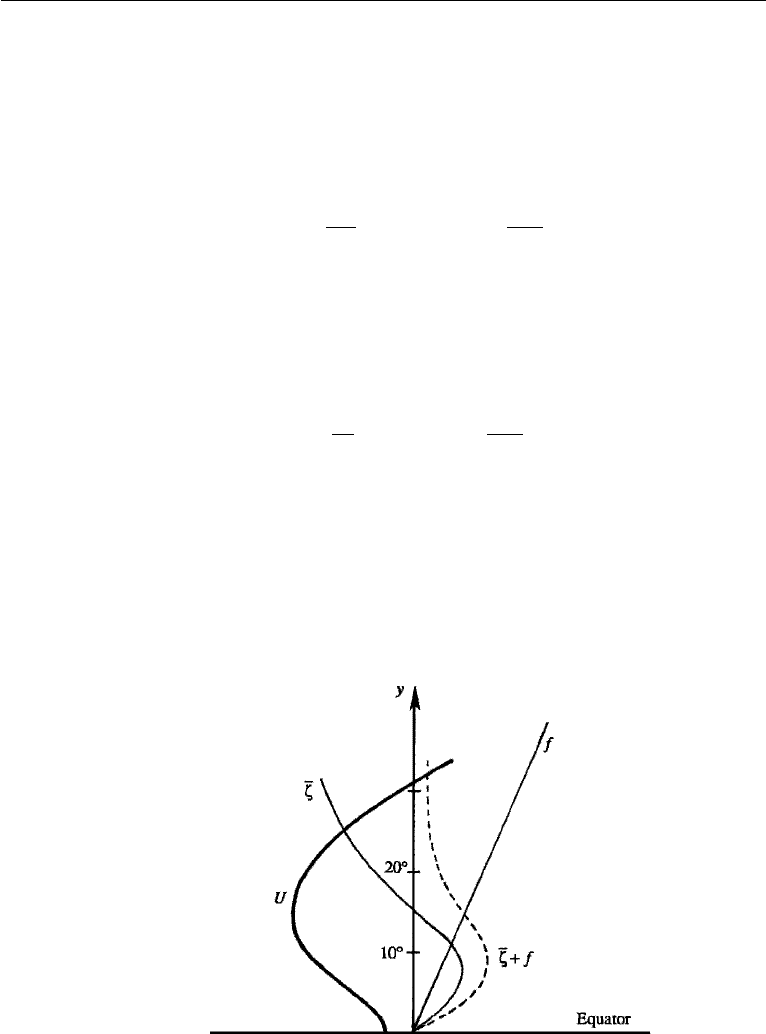
664 Geophysical Fluid Dynamics
Because the coefficients of equation (14.123) are independent of x and t, there can
be solutions of the form
ψ =
ˆ
ψ(y)e
ik(x−ct)
.
The phase speed c is complex and solutions are unstable if its imaginary part c
i
> 0.
The perturbation vorticity equation (14.123) then becomes
(U − c)
d
2
dy
2
− k
2
ˆ
ψ +
β −
d
2
U
dy
2
ˆ
ψ = 0.
Comparing this with equation (12.76) derived without Coriolis forces, it is seen that
the effect of planetary rotation is the replacement of −d
2
U/dy
2
by (β − d
2
U/dy
2
).
The analysis of the section therefore carries over to the present case, resulting in the
following criterion: A necessary condition for the inviscid instability of a barotropic
current U(y) is that the gradient of the absolute vorticity
d
dy
(
¯
ζ + f) = β −
d
2
U
dy
2
, (14.124)
must change sign somewhere in the flow. This result was first derived by Kuo (1949).
Barotropic instability quite possibly plays an important role in the instability of
currents in the atmosphere and in the ocean. The instability has no preference for any
latitude, because the criterion involves β and not f . However, the mechanism presum-
ably dominates in the tropics because midlatitude disturbances prefer the baroclinic
instability mechanism discussed in the following section. An unstable distribution of
westward tropical wind is shown in Figure 14.29.
Figure 14.29 Profiles of velocity and vorticity of a westward tropical wind. The velocity distribution is
barotropically unstable as d(
¯
ζ + f )/dy changes sign within the flow. J. T. Houghton, The Physics of the
Atmosphere, 1986 and reprinted with the permission of Cambridge University Press.
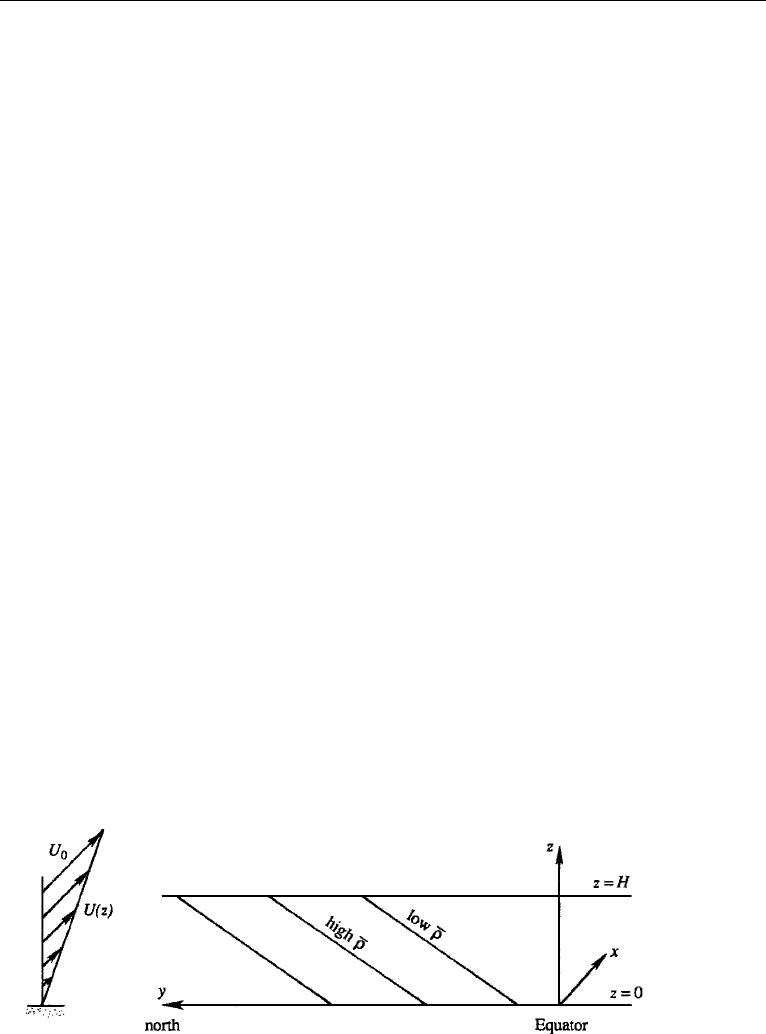
17. Baroclinic Instability 665
17. Baroclinic Instability
The weather maps at midlatitudes invariably show the presence of wavelike horizontal
excursions of temperature and pressure contours, superposed on eastward mean flows
such as the jet stream. Similar undulations are also found in the ocean on eastward
currents such as the Gulf Stream in the north Atlantic. A typical wavelength of these
disturbances is observed to be of the order of the internal Rossby radius, that is, about
4000 km in the atmosphere and 100 km in the ocean. They seem to be propagating as
Rossby waves, but their erratic and unexpected appearance suggests that they are not
forced by any external agency, but are due to an inherent instability of midlatitude
eastward flows. In other words, the eastward flows have a spontaneous tendency
to develop wavelike disturbances. In this section we shall investigate the instability
mechanism that is responsible for the spontaneous relaxation of eastward jets into a
meandering state.
The poleward decrease of the solar irradiation results in a poleward decrease of
the temperature and a consequent increase of the density. An idealized distribution of
the atmospheric density in the northern hemisphere is shown in Figure 14.30. The den-
sity increases northward due to the lower temperatures near the poles and decreases
upward because of static stability. According to the thermal wind relation (14.15),
an eastward flow (such as the jet stream in the atmosphere or the Gulf Stream in
the Atlantic) in equilibrium with such a density structure must have a velocity that
increases with height. A system with inclined density surfaces, such as the one in
Figure 14.30, has more potential energy than a system with horizontal density sur-
faces, just as a system with an inclined free surface has more potential energy than a
system with a horizontal free surface. It is therefore potentially unstable because
it can release the stored potential energy by means of an instability that would
cause the density surfaces to flatten out. In the process, vertical shear of the mean
flow U(z) would decrease, and perturbations would gain kinetic energy.
Instability of baroclinic jets that release potential energy by flattening out the
density surfaces is called the baroclinic instability. Our analysis would show that the
preferred scale of the unstable waves is indeed of the order of the Rossby radius, as
observed for the midlatitude weather disturbances. The theory of baroclinic instability
Figure 14.30 Lines of constant density in the northern hemispheric atmosphere. The lines are nearly
horizontal and the slopes are greatly exaggerated in the figure. The velocity U(z) is into the plane of
paper.

666 Geophysical Fluid Dynamics
was developed in the 1940s by Bjerknes et al. and is considered one of the major
triumphs of geophysical fluid mechanics. Our presentation is essentially based on the
review article by Pedlosky (1971).
Consider a basic state in which the density is stably stratified in the vertical
with a uniform buoyancy frequency N, and increases northward at a constant rate
∂ ¯ρ/∂y. According to the thermal wind relation, the constancy of ∂ ¯ρ/∂y requires that
the vertical shear of the basic eastward flow U(z) also be constant. The β-effect is
neglected as it is not an essential requirement of the instability. (The β-effect does
modify the instability, however.) This is borne out by the spontaneous appearance of
undulations in laboratory experiments in a rotating annulus, in which the inner wall
is maintained at a higher temperature than the outer wall. The β-effect is absent in
such an experiment.
Perturbation Vorticity Equation
The equations for total flow are
∂u
∂t
+ u
∂u
∂x
+ v
∂u
∂y
− fv =−
1
ρ
0
∂p
∂x
,
∂v
∂t
+ u
∂v
∂x
+ v
∂v
∂y
+ fu =−
1
ρ
0
∂p
∂y
,
0 =−
∂p
∂z
− ρg, (14.125)
∂u
∂x
+
∂v
∂y
+
∂w
∂z
= 0,
∂ρ
∂t
+ u
∂ρ
∂x
+ v
∂ρ
∂y
+ w
∂ρ
∂z
= 0,
where ρ
0
is a constant reference density. We assume that the total flow is composed of
a basic eastward jet U(z) in geostrophic equilibrium with the basic density structure
¯ρ(y, z) shown in Figure 14.30, plus perturbations. That is,
u = U(z) + u
(x,y,z),
v = v
(x,y,z),
w = w
(x,y,z),
ρ =¯ρ(y, z) +ρ
(x,y,z),
p =¯p(y, z) + p
(x,y,z).
(14.126)
The basic flow is in geostrophic and hydrostatic balance:
fU =−
1
ρ
0
∂ ¯p
∂y
,
0 =−
∂ ¯p
∂z
−¯ρg.
(14.127)

17. Baroclinic Instability 667
Eliminating the pressure, we obtain the thermal wind relation
dU
dz
=
g
fρ
0
∂ ¯ρ
∂y
, (14.128)
which states that the eastward flow must increase with height because ∂ ¯ρ/∂y > 0.
For simplicity, we assume that ∂ ¯ρ/∂y is constant, and that U = 0 at the surface z = 0.
Thus the background flow is
U =
U
0
z
H
,
where U
0
is the velocity at the top of the layer at z = H .
We first form a vorticity equation by cross differentiating the horizontal equations
of motion in equation (14.125), obtaining
∂ζ
∂t
+ u
∂ζ
∂x
+ v
∂ζ
∂y
− (ζ + f)
∂w
∂z
= 0. (14.129)
This is identical to equation (14.92), except for the exclusion of the β-effect here; the
algebraic steps are therefore not repeated. Substituting the decomposition (14.126),
and noting that ζ = ζ
because the basic flow U = U
0
z/H has no vertical component
of vorticity, (14.129) becomes
∂ζ
∂t
+ U
∂ζ
∂x
− f
∂w
∂z
= 0, (14.130)
where the nonlinear terms have been neglected. This is the perturbation vorticity
equation, which we shall now write in terms of p
.
Assume that the perturbations are large-scale and slow, so that the velocity is
nearly geostrophic:
u
−
1
ρ
0
f
∂p
∂y
,v
1
ρ
0
f
∂p
∂x
, (14.131)
from which the perturbation vorticity is found as
ζ
=
1
ρ
0
f
∇
2
H
p
. (14.132)
We now express w
in equation (14.130) in terms of p
. The density equation gives
∂
∂t
( ¯ρ + ρ
) + (U + u
)
∂
∂x
( ¯ρ + ρ
) + v
∂
∂y
( ¯ρ + ρ
) + w
∂
∂z
( ¯ρ + ρ
) = 0 .
Linearizing, we obtain
∂ρ
∂t
+ U
∂ρ
∂x
+ v
∂ ¯ρ
∂y
−
ρ
0
N
2
w
g
= 0, (14.133)
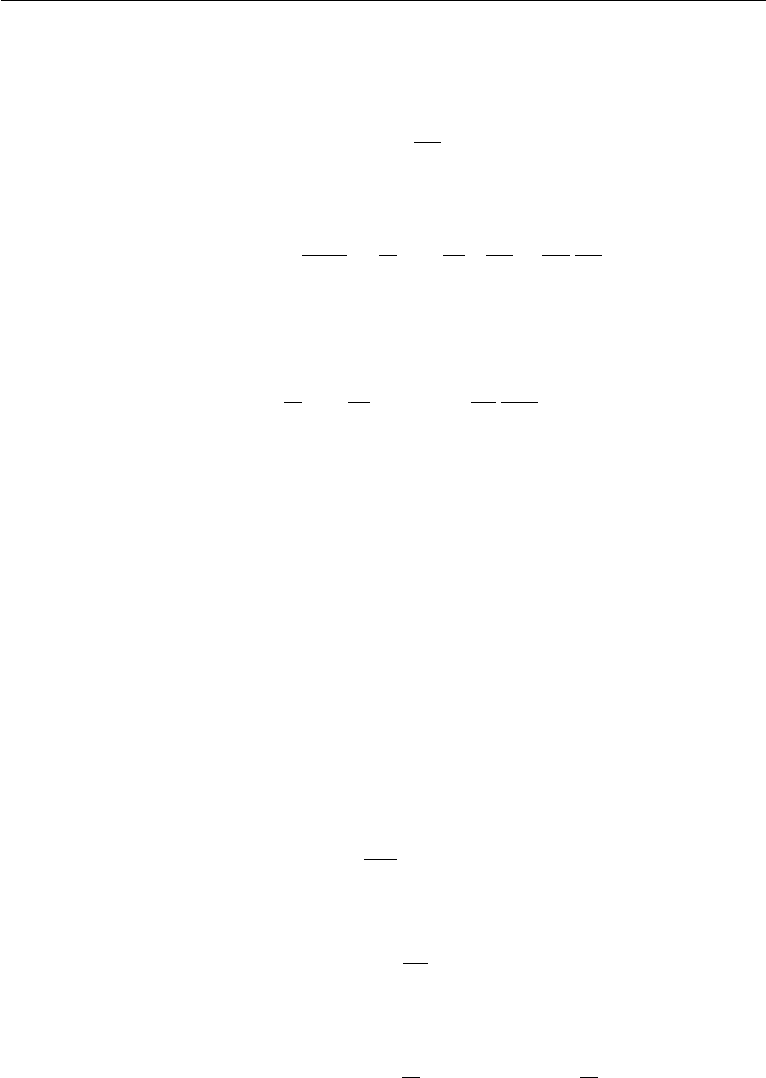
668 Geophysical Fluid Dynamics
where N
2
=−gρ
−1
0
(∂ ¯ρ/∂z). The perturbation density ρ
can be written in terms of
p
by using the hydrostatic balance in equation (14.125), and subtracting the basic
state (14.127). This gives
0 =−
∂p
∂z
− ρ
g, (14.134)
which states that the perturbations are hydrostatic. Equation (14.133) then gives
w
=−
1
ρ
0
N
2
∂
∂t
+ U
∂
∂x
∂p
∂z
−
dU
dz
∂p
∂x
, (14.135)
where we have written ∂ ¯ρ/∂y in terms of the thermal wind dU/dz. Using equa-
tions (14.132) and (14.135), the perturbation vorticity equation (14.130) becomes
∂
∂t
+ U
∂
∂x
∇
2
H
p
+
f
2
N
2
∂
2
p
∂z
2
= 0. (14.136)
This is the equation that governs the quasi-geostrophic perturbations on an eastward
current U(z).
Wave Solution
We assume that the flow is confined between two horizontal planes at z = 0 and
z = H and that it is unbounded in x and y. Real flows are likely to be bounded in the
y direction, especially in a laboratory situation of flow in an annular region, where the
walls set boundary conditions parallel to the flow. The boundedness in y, however,
simply sets up normal modes in the form sin(nπy/L), where L is the width of the
channel. Each of these modes can be replaced by a periodicity in y. Accordingly, we
assume wavelike solutions
p
=ˆp(z) e
i(kx+ly−ωt)
. (14.137)
The perturbation vorticity equation (14.136) then gives
d
2
ˆp
dz
2
− α
2
ˆp = 0, (14.138)
where
α
2
≡
N
2
f
2
(k
2
+ l
2
). (14.139)
The solution of equation (14.138) can be written as
ˆp = A cosh α
z −
H
2
+ B sinh α
z −
H
2
. (14.140)
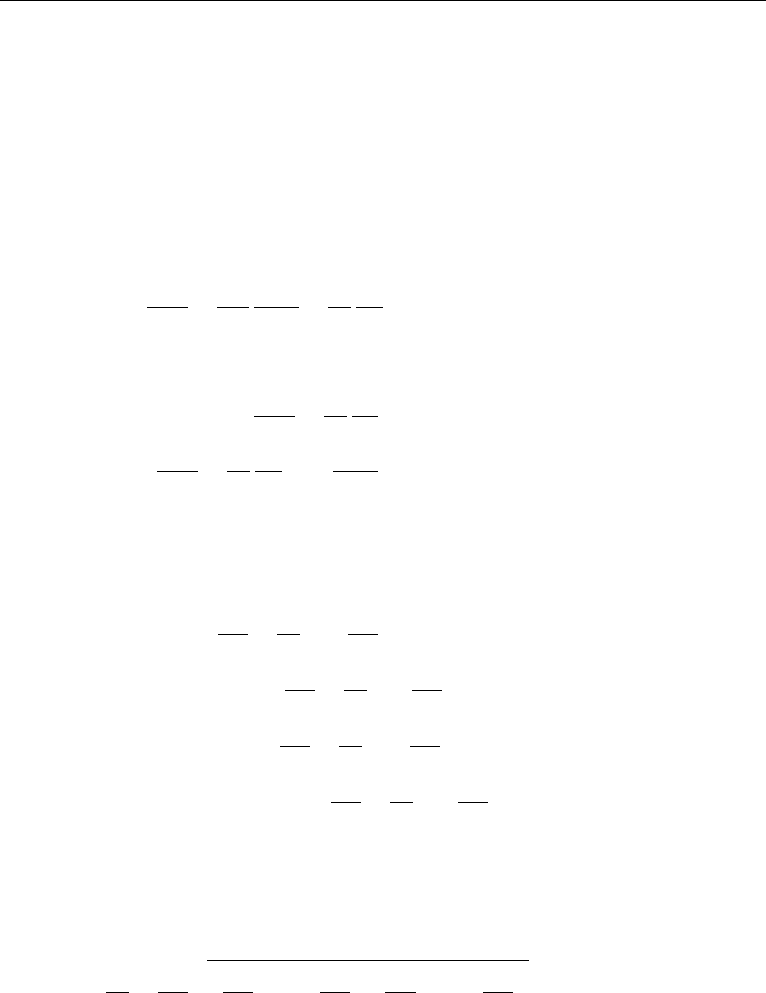
17. Baroclinic Instability 669
Boundary conditions have to be imposed on solution (14.140) in order to derive an
instability criterion.
Boundary Conditions
The conditions are
w
= 0atz = 0,H.
The corresponding conditions on p
can be found from equation (14.135) and
U = U
0
z/H . We obtain
−
∂
2
p
∂t ∂z
−
U
0
z
H
∂
2
p
∂x ∂z
+
U
0
H
∂p
∂x
= 0atz = 0,H,
where we have also used U = U
0
z/H . The two boundary conditions are therefore
∂
2
p
∂t ∂z
−
U
0
H
∂p
∂x
= 0atz = 0,
∂
2
p
∂t ∂z
−
U
0
H
∂p
∂x
+ U
0
∂
2
p
∂x ∂z
= 0atz = H.
Instability Criterion
Using equations (14.137) and (14.140), the foregoing boundary conditions require
A
αc sinh
αH
2
−
U
0
H
cosh
αH
2
+ B
−αc cosh
αH
2
+
U
0
H
sinh
αH
2
= 0,
A
α(U
0
− c) sinh
αH
2
−
U
0
H
cosh
αH
2
+ B
α(U
0
− c) cosh
αH
2
−
U
0
H
sinh
αH
2
= 0,
where c = ω/k is the eastward phase velocity.
This is a pair of homogeneous equations for the constants A and B. For nontrivial
solutions to exist, the determinant of the coefficients must vanish. This gives, after
some straightforward algebra, the phase velocity
c =
U
0
2
±
U
0
αH
αH
2
− tanh
αH
2
αH
2
− coth
αH
2
. (14.141)
Whether the solution grows with time depends on the sign of the radicand. The
behavior of the functions under the radical sign is sketched in Figure 14.31. It is
apparent that the first factor in the radicand is positive because αH/2 > tanh(αH/2)
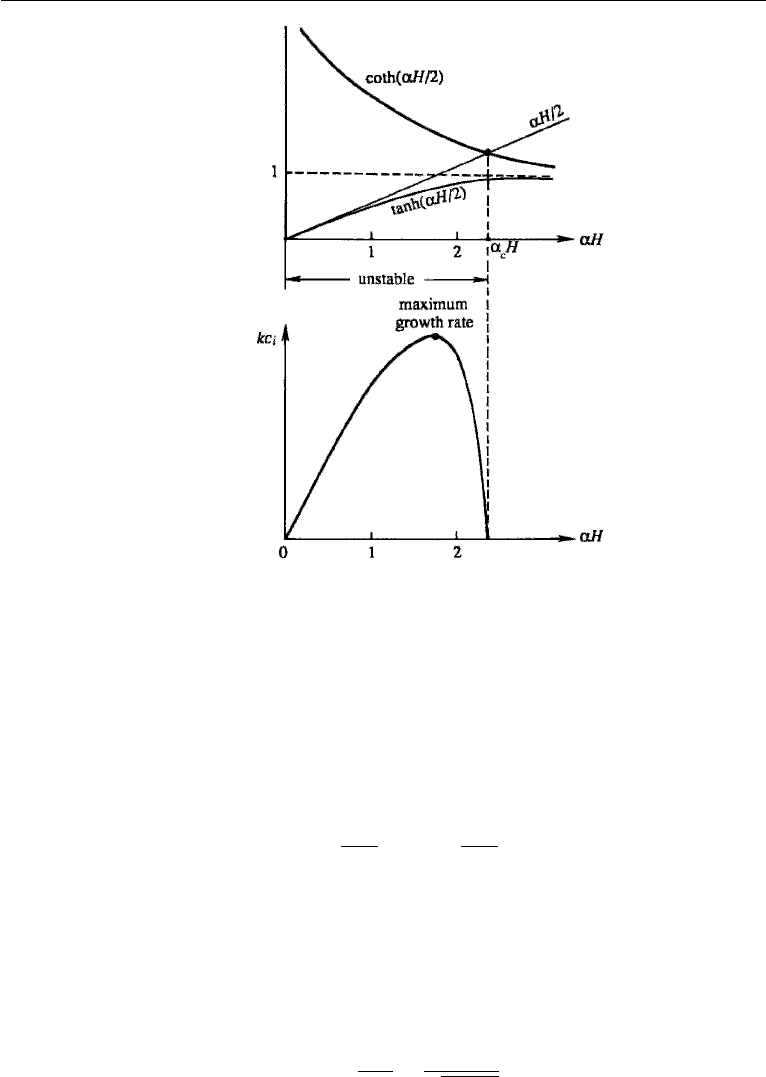
670 Geophysical Fluid Dynamics
Figure 14.31 Baroclinic instability. The upper panel shows behavior of the functions in equation (14.141),
and the lower panel shows growth rates of unstable waves.
for all values of αH. However, the second factor is negative for small values of αH
for which αH/2 < coth(αH/2). In this range the roots of c are complex conjugates,
with c = U
0
/2 ±ic
i
. Because we have assumed that the perturbations are of the form
exp(−ikct), the existence of a nonzero c
i
implies the possibility of a perturbation
that grows as exp(kc
i
t), and the solution is unstable. The marginal stability is given
by the critical value of α satisfying
α
c
H
2
= coth
α
c
H
2
,
whose solution is
α
c
H = 2.4,
and the flow is unstable if αH < 2.4. Using the definition of α in equation (14.139),
it follows that the flow is unstable if
HN
f
<
2.4
√
k
2
+ l
2
.

17. Baroclinic Instability 671
As all values of k and l are allowed, we can always find a value of k
2
+l
2
low enough
to satisfy the forementioned inequality. The flow is therefore always unstable (to low
wavenumbers). For a north–south wavenumber l = 0, instability is ensured if the
east–west wavenumber k is small enough such that
HN
f
<
2.4
k
. (14.142)
In a continuously stratified ocean, the speed of a long internal wave for the n = 1
baroclinic mode is c = NH/π, so that the corresponding internal Rossby radius is
c/f = NH /πf . It is usual to omit the factor π and define the Rossby radius in a
continuously stratified fluid as
≡
HN
f
.
The condition (14.142) for baroclinic instability is therefore that the east–west wave-
length be large enough so that
λ>2.6.
However, the wavelength λ = 2.6 does not grow at the fastest rate. It can be
shown from equation (14.141) that the wavelength with the largest growth rate is
λ
max
= 3.9.
This is therefore the wavelength that is observed when the instability develops. Typical
values for f , N, and H suggest that λ
max
∼ 4000 km in the atmosphere and 200 km
in the ocean, which agree with observations. Waves much smaller than the Rossby
radius do not grow, and the ones much larger than the Rossby radius grow very slowly.
Energetics
The foregoing analysis suggests that the existence of “weather waves” is due to the
fact that small perturbations can grow spontaneously when superposed on an eastward
current maintained by the sloping density surfaces (Figure 14.30). Although the basic
current does have a vertical shear, the perturbations do not grow by extracting energy
from the vertical shear field. Instead, they extract their energy from the potential
energy stored in the system of sloping density surfaces. The energetics of the baroclinic
instability is therefore quite different than that of the Kelvin–Helmholtz instability
(which also has a vertical shear of the mean flow), where the perturbation Reynolds
stress
u
w
interacts with the vertical shear and extracts energy from the mean shear
flow. The baroclinic instability is not a shear flow instability; the Reynolds stresses
are too small because of the small w in quasi-geostrophic large-scale flows.
The energetics of the baroclinic instability can be understood by examining the
equation for the perturbation kinetic energy. Such an equation can be derived by
